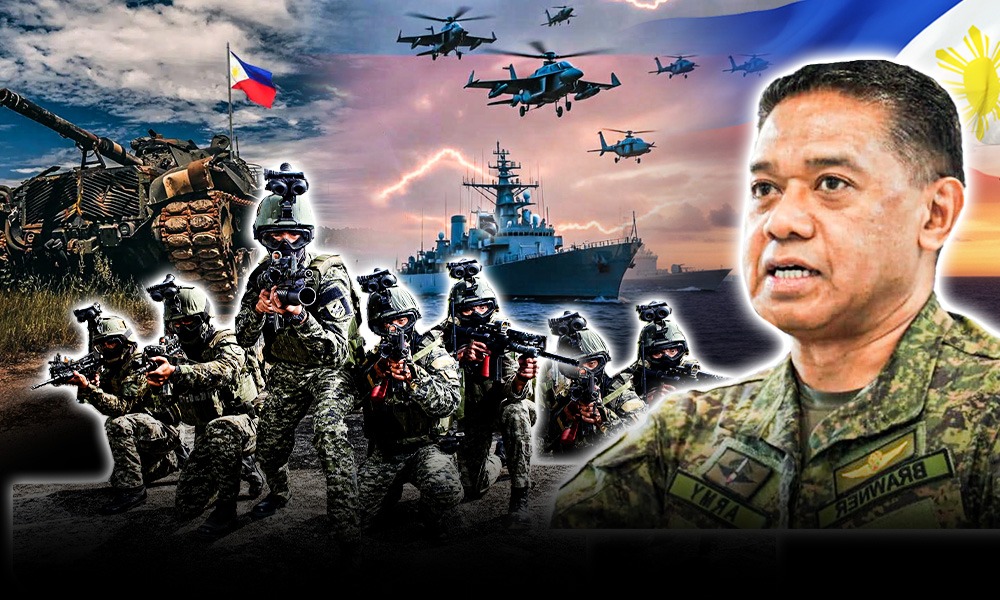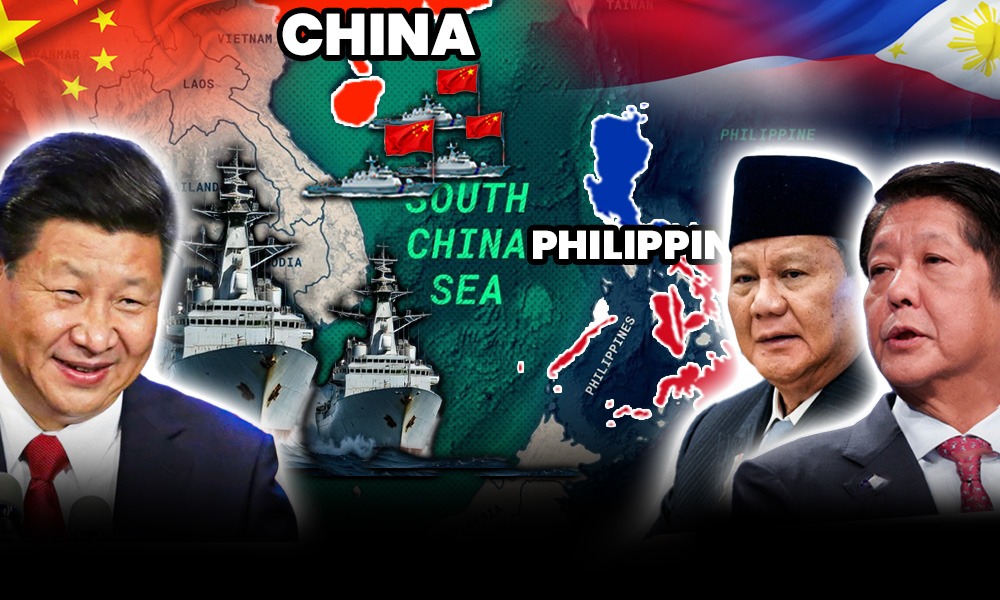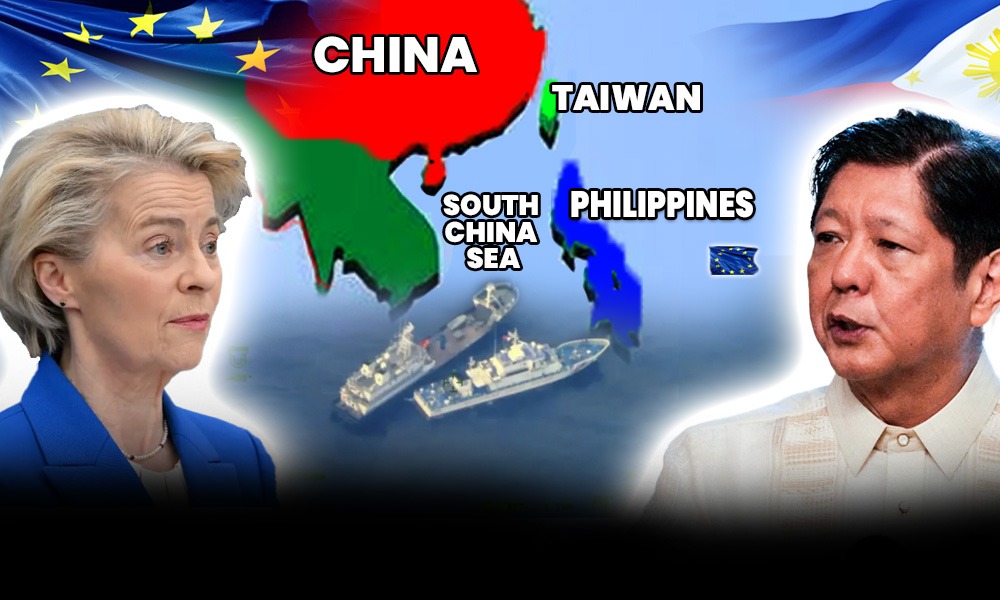Philippines Prepares to Fight Alone for 30 Days if War Breaks Out
In a striking and sobering statement, General Romeo Brawner Jr., Chief of Staff of the Armed Forces of the Philippines (AFP), declared: “We will be the ones to go to war first. We should be able to fight and preserve our forces for at least 20 to 30 days.” This declaration captures the essence of the Philippines’ new defense posture, one grounded in self-reliance, readiness, and realism. The comment comes amid rising tensions in the West Philippine Sea (WPS), where the Philippines continues to face escalating grey-zone pressure and coercive maneuvers from China’s coast guard and maritime militia. Beijing’s sweeping territorial claims and aggressive tactics have created near-daily confrontations, testing Manila’s resolve and exposing the limits of its current defense capabilities.
At the heart of this new doctrine lies a hard truth: in the event of open conflict, the Philippines expects to fight alone, at least initially. Under the 1951 Mutual Defense Treaty (MDT), U.S. intervention is assured only after certain conditions are met, such as confirmation of an “armed attack” against Philippine forces or vessels. That process could take time, time that the AFP would need to survive and hold on its own. Hence, the guiding premise of Brawner’s statement: the country must be able to resist, defend, and sustain operations independently for at least 20 to 30 days before allied forces can intervene decisively. This raises urgent strategic questions, the very questions shaping defense planning today: What happens in those first 20 to 30 days? What capabilities does the Philippines currently possess to withstand aggression? How might China respond militarily or politically? What would allied powers like the U.S., Japan, and Australia contribute once they engage? And ultimately, can Manila truly hold the line long enough for help to arrive? These are no longer hypothetical discussions. They define the Philippines’ evolving defense doctrine and the next phase of its modernization, a shift from reliance to resilience, from reaction to readiness.
What If the Fighting Starts — The Initial Phase
If a conflict breaks out in the West Philippine Sea, the first 20 to 30 days will be the most crucial and the most difficult, for the Philippines. This is the period during which the Armed Forces of the Philippines (AFP) must hold the line alone, without direct allied military intervention, as the mechanisms of the 1951 Mutual Defense Treaty (MDT) and allied coordination take time to activate. As General Romeo Brawner Jr. explained, “Our allies and our partners are expecting us to fight the war ourselves during the initial phase of the conflict.” His statement shows a stark reality: while Manila can rely on long-term support from its allies, it must first survive the opening phase of a war on its own strength and preparation.
The possible triggers for such a conflict are many, and all are plausible. A clash near the Second Thomas Shoal, where Chinese Coast Guard vessels have repeatedly harassed and rammed Philippine resupply missions, could easily spiral into open hostilities. A blockade of Philippine outposts, cutting off fuel or supplies, or the sudden massing of hundreds of Chinese maritime militia vessels near contested features like Whitsun Reef or Scarborough Shoal could serve as the spark. Any of these could force Manila to respond militarily, marking the beginning of the 20–30 day window that the AFP is preparing for.
During this period, “holding the line” would mean a combination of defensive endurance, operational resilience, and strategic communication. On land, forces on Luzon and Palawan would protect key military and logistical hubs, ports, airfields, radar sites, and command centers, while mobilizing coastal defense units to counter potential amphibious or missile strikes. At sea, the Philippine Navy and Coast Guard, supported by surveillance from the Bureau of Fisheries and Aquatic Resources (BFAR), would maintain patrols and intelligence gathering to track enemy movements. The focus would not be on winning decisive battles but on surviving the initial shock, preserving combat power, and preventing rapid territorial losses.
Logistics and communication would be equally critical. The AFP would need to operate under conditions of cyber disruption, GPS jamming, and information warfare, as China’s first moves would likely aim to cripple command-and-control systems. Resupply chains, already stretched across the archipelago, would come under immense pressure, forcing reliance on prepositioned fuel, ammunition, and food stores. Mobile command units and redundant communication systems would be key to maintaining coordination among scattered forces.
The risk of escalation during this phase would be extraordinarily high. A single miscalculation, a downed aircraft, a sinking vessel, or civilian casualties, could rapidly widen the conflict. The United States would closely monitor events, but formal intervention would depend on political authorization and proof of an “armed attack” under the MDT. Even with rapid mobilization, deploying significant allied forces to Philippine territory could take days or weeks. Until then, Manila’s mission would be clear but daunting: hold its ground, protect its sovereignty, and keep the nation’s defenses intact long enough for reinforcements to arrive.
This 20–30 day window is therefore more than a military challenge, it is a test of endurance, discipline, and national will. For the Philippines, it represents the gap between vulnerability and salvation, a period where its own strength and preparation will determine whether allies can arrive to help in time.
Luzon Strait: How the U.S. and Philippines Plan to Deter China’s Navy
Philippine Army Capabilities
The Philippine Army’s job in the first 20–30 days is to be the nation’s shock absorber: hold key terrain, keep critical bases alive, and deny the enemy an easy win while the rest of the force and allies spin up. That means defending ports, airfields, radar and comms hubs on Luzon and Palawan; securing bridges, mountain passes, and coastal approaches; and setting up layered ground-based defenses to blunt or complicate any amphibious probes or missile strikes. In practice, the Army must fight dispersed and survive, hardening positions, moving command posts, using camouflage and decoys, and integrating coastal defense fires, short-range air defense, counter-UAS measures, engineers, and territorial reserve units. The end state isn’t flashy: it’s preventing a quick collapse, preserving combat power, and keeping national decision-makers options on Day 5, Day 10, and Day 25.
This posture flows directly from the recent directive to “fight and preserve our forces for at least 20 to 30 days” if war breaks out, as emphasized by AFP leadership. It is an explicit shift from “wait for help” to “hold long enough for help to matter.” Within that window, the Army’s tempo is about endurance, rotating battalions through prepared defensive belts, protecting fuel and ammo stocks, and keeping logistics arteries open despite cyber pressure, GPS spoofing, and interdiction attempts. Every day survives, buys time for maritime and air reinforcements, international diplomacy, and allied decision cycles.
On paper, the Philippines sits 37th in the 2025 Military Power Rankings with an MPR score of 758, a reminder of both progress and limits. Historically, the Army has been under-funded and oriented toward internal security, counterinsurgency, civil-military operations, disaster response, rather than high-intensity, joint warfighting against a peer. That imprint shows gaps: limited integrated air defense, modest long-range fires, and a sustainment system optimized for island-hopping constabulary missions, not contested, multi-domain logistics under fire.
U.S. Missiles in Philippines Can REACH China Faster Than You Think
Modernization is underway to close that gap. Large-scale joint drills like AJEX-DAGITPA are building muscle memory across Army, Air Force, and Navy for archipelagic operations: contested lodgments, coastal defense fires, forward arming and refueling points, and joint fires deconfliction. Doctrinally, the Army is aligning to the Comprehensive Archipelagic Defense Concept (CADC) and the “Bantay Kalayaan” territorial defense plan, prioritizing sea-denial support from the shore, rapid mobility between islands, and integration with coastal missile batteries, ISR drones, and partner ISR feeds. The focus is on making ground forces the anchor of a wider kill-web: spotting, fixing, and cueing joint and allied fires while denying the enemy easy targets ashore.
Where the fight gets decided, though, is logistics and sustainment. Island terrain and contested seas make every liter of fuel and each pallet of 155mm or MANPADS a mini-campaign. The Army will need prepositioned stocks near defended nodes; mobile, small-footprint “pulsed” resupply by night or under weather; shallow-draft craft and tactical landing zones to bypass interdicted ports; and redundant comms (HF/VHF, sat back-ups, line-of-sight relays) to keep orders flowing when primary networks are jammed. Medical evacuation and casualty care demand layered solutions, combat lifesaver training down to squad level, distributed Role 1/2 facilities, and opportunistic air or sea casevac when windows open. Rotation cycles must be short enough to manage fatigue but long enough to minimize exposure during movement; commanders will lean on local government units, coast guard, and civilian contractors for haulage and staging, while accepting that contested conditions will make schedules elastic and attrition real.
In short, the Army’s role in the opening month is endurance under pressure: deny the adversary a quick decisive effect, keep the nation’s military spine intact, and hold the door open for joint and allied power to arrive. Success won’t look like sweeping offensives; it will look like functional airstrips on Day 21, radars still blinking on Day 24, and battalions that can still shoot, move, communicate and fight again, on Day 30.
Philippine Air Force and Air Capabilities
The Philippine Air Force (PAF) serves as the aerial defense component of the Armed Forces of the Philippines (AFP) and plays a critical role in maintaining the country’s sovereignty, territorial integrity, and maritime security. As an archipelagic nation surrounded by vast sea lanes, the Philippines depends heavily on its air arm to monitor and protect its maritime approaches. The PAF’s functions extend beyond conventional combat roles to include maritime patrol, aerial surveillance, early warning, rapid reaction, and deterrence, making it the “eyes in the sky” of the armed forces.
A key element of the PAF’s role is maritime patrol and surveillance. Airborne platforms provide essential intelligence and situational awareness over the country’s extensive Exclusive Economic Zone (EEZ), particularly in the West Philippine Sea. Through patrol and reconnaissance missions, the Air Force helps detect and track foreign vessels, monitor illegal activities, and support naval operations. Aircraft such as the C-295 and NC-212i light transport planes, along with FA-50 fighter jets and radar-equipped helicopters, contribute to this mission. These operations not only enhance maritime domain awareness but also act as a visible symbol of national sovereignty.
The PAF also undertakes rapid reaction and deterrence missions, deploying air assets for immediate response to incursions, disasters, or security threats. The ability to scramble aircraft quickly, whether for intercepts, humanitarian assistance, or island resupply, shows the Air Force’s value as a flexible and responsive component of national defense. Even when direct engagement is not intended, the visible presence of aircraft serves as a form of deterrence, signaling the country’s resolve to protect its territories.
In 2025, the Philippines and the United States launched a new joint military task force designed to improve combined planning, readiness, and interoperability between the two nations. According to Reuters reports (October–November 2025), this Joint Task Force focuses on maritime and aerial cooperation, particularly in the South China Sea. Earlier in the year, the U.S. and Philippine air forces conducted joint patrols involving FA-50 fighter jets and American bombers to enhance air domain awareness and strengthen deterrence against aggressive maneuvers in contested waters. These efforts demonstrate how the PAF’s air surveillance and deterrence roles are being reinforced through alliance cooperation and capability sharing.
France to Supply 40 Fast Patrol Boats for the Philippines to Defend the West Philippine Sea
During the initial phase of joint operations, the PAF’s main contribution centers on aerial surveillance and early warning. Its aircraft monitor maritime activity, detect potential incursions, and relay information to naval and ground units. This air coverage supports naval and island operations, particularly in remote outposts, and ensures the protection of supply routes connecting key bases and civilian areas. The PAF’s surveillance data also enhance situational awareness for allied forces, improving the coordination of maritime patrols and quick-reaction responses.
Despite these growing responsibilities, the PAF continues to face significant constraints. It operates a limited number of modern combat aircraft, and maintenance and logistics challenges often affect fleet readiness. The service’s aircraft inventory still lags behind regional counterparts, with many units relying on refurbished or imported second-hand platforms. The limited range and endurance of existing aircraft restrict continuous patrol coverage over distant maritime zones. According to analyses by the International Crisis Group, modernization is ongoing under the Revised AFP Modernization Program, but the force remains in a “catch-up phase,” seeking to balance immediate operational demands with long-term capability development.
Nevertheless, modernization is reshaping the Air Force’s future. Acquisitions such as the FA-50PH light fighters, Black Hawk helicopters, and planned multirole fighter aircraft signal a gradual transition toward a more capable and autonomous air force. With continued U.S. partnership and regional cooperation, the PAF is enhancing its ability to serve as an effective maritime guardian, deterrent force, and rapid response component, safeguarding the Philippines’ sovereignty and stability in a highly contested regional environment.
China’s Possible Reaction
If escalation begins, Beijing is likely to surge a layered mix of maritime militia, China Coast Guard (CCG) and PLA Navy assets into contested features and chokepoints, while stepping up airspace incursions and fast-tracking fortification (temporary shelters, buoys, barriers) around shoals. This playbook lets China mass presence quickly without immediately crossing the threshold of open war, while holding regular PLA forces just over the horizon as a latent threat. Recent PLA statements branding Manila a “troublemaker” and announcing close tracking of Philippine patrols shows how fast Beijing moves to frame and counter new allied steps. Expect intensified grey-zone coercion already familiar in the Philippine context: coordinated maritime-militia swarms, deliberate near-collisions, lasers and especially water-cannoning of resupply and coast-guard vessels. These tactics have repeatedly damaged Philippine ships and injured crew near Second Thomas and Scarborough in 2024–2025, and are designed to exhaust Manila’s will while avoiding kinetic escalation.
Strategically, China’s aim is to coerce and degrade Philippine capability and resolve, shift facts on the water incrementally, and avoid a set-piece war that would invite allied intervention. Grey-zone operations help Beijing build a new normal, impose operational costs, and cultivate narratives that Manila is the escalator.
Ukraine’s Combat UAV Steals the Show at Philippines Defense Exhibition
On the diplomatic/legal front, Beijing will likely deny escalation, contest treaty thresholds, and cast the Philippines as the provocateur, while rejecting adverse legal findings such as the 2016 award. This narrative management is synchronized with on-water pressure to complicate allied responses and keep incidents below clear “armed attack” definitions.
Risk: Miscalculation is high. A serious clash (e.g., ramming-plus-boarding, major injuries, or a disabled ship) could trigger allied involvement under the U.S.–Philippines Mutual Defense Treaty (MDT) and a regional crisis; the core MDT articles cover armed attacks on Philippine public vessels, aircraft, or armed forces in the Pacific, which Washington has repeatedly affirmed apply to the West Philippine Sea.
Global Players & Allied Support
United States. Manila’s core treaty ally under the 1951 MDT, the U.S. provides the backbone of external deterrence and reinforcement. Philippine strategy assumes national forces must hold the line until U.S. and partners can flow combat power and logistics. (See MDT scope and interpretations via CFR.) Washington and Manila just stood up “Task Force-Philippines,” a new bilateral formation to tighten combined planning, readiness and interoperability focused on the South China Sea, an explicit signal of allied resolve and faster decision cycles.
Other partners. Ties are widening with Japan (a Reciprocal Access Agreement now in force and already operationalized), Australia (strategic partnership, major exercises), and Canada (a new SOVFA signed in Nov 2025 allowing troops to train on each other’s soil). These frameworks underpin joint exercises, access, and rapid logistics, reinforcing a rules-based order narrative. The timing gap. Even with strong allies, there’s a first 20–30 days when Manila must absorb pressure while reinforcements mobilize and sail/fly, hence the emphasis on stockpiles, dispersal, and command resilience in the opening month.
Philippines’ Capability to Fight for 30 Days
AFP leadership has publicly set a benchmark to withstand the initial blow and hold for ~20–30 days before allied help fully arrives, “we will be the ones to go to war first.” What that requires. Success hinges on: (1) Sustainment, ammo, fuel, food, medical stocks pre-positioned and protected; (2) Force rotation & relocation across islands under pressure; (3) Communications & C2 integrity amid jamming and persistent ISR; (4) Logistics resilience despite blockade attempts and periodic air/sea denial; and (5) Morale & training for high-intensity ops. Modernization is underway but gaps remain, Crisis Group notes the AFP is still catching up even as procurement accelerates. Independent indices likewise place the Philippines in the middle tier of global military power, showing both progress and limits. Assessment. A 30-day hold is ambitious but plausible if Manila avoids early catastrophic losses, disperses assets, protects lift and ISR, and leverages allied intelligence, planning and logistics support fast. The outcome turns on preparedness and tempo more than on platform counts alone.
Philippines $1.9B Hanwha Submarine Deal With South Korea to Deter China in SCS
Conclusion
Manila is moving from a reactive claimant to a front-edge defender, prepared to fight first, hold, and then integrate allied mass. The stakes are high: the West Philippine Sea sits astride global trade routes and contested sovereignty claims; outcomes there will shape regional order far beyond the immediate littoral. 20–30 day window is Manila’s crucible: hold firm and deterrence strengthens; falter early and leverage erodes. As AFP Chief Gen. Romeo Brawner Jr. put it: “We will be the ones to go to war first, We must be able to weather the initial attack and hold the line until reinforcements arrive.”



